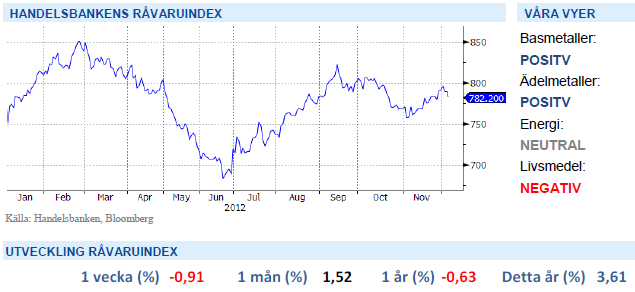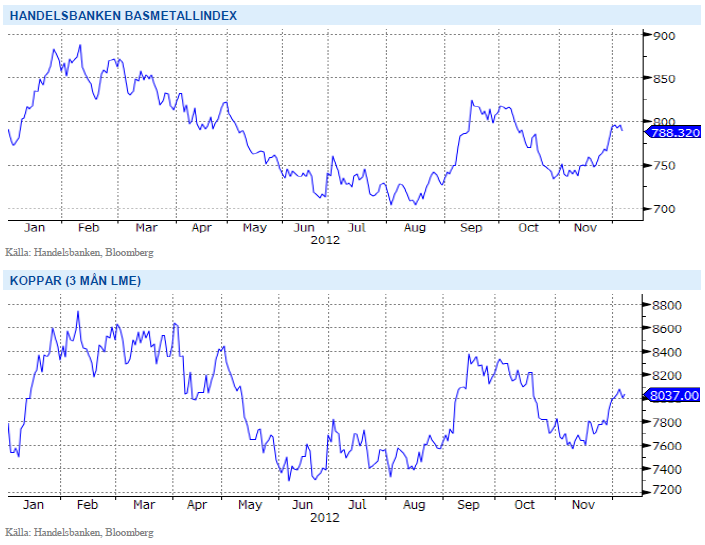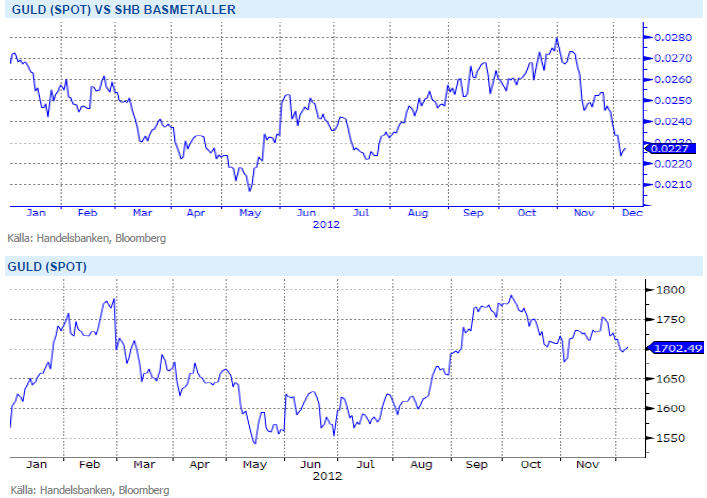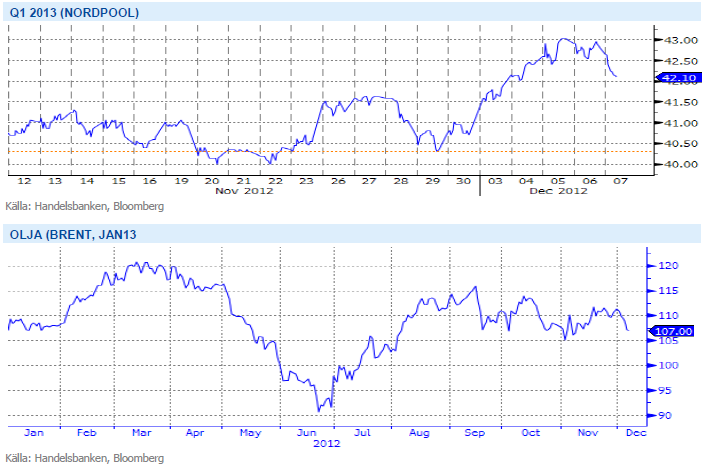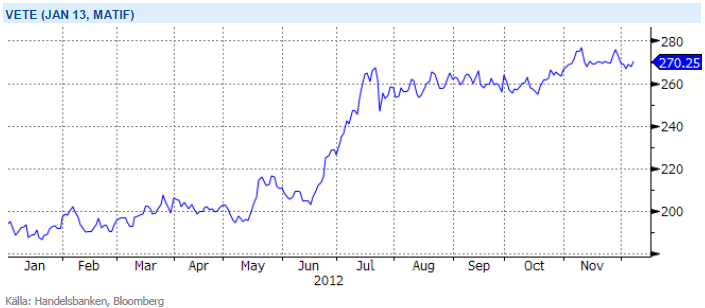Analys
SHB Råvarubrevet 7 december 2012
 Råvaror allmänt
Råvaror allmänt
Global förbättring
Dataskörden sedan förra veckan förstärker bilden om en starkare global konjunktur. Amerikansk inhemsk efterfrågan växer snabbare men industrin hålls tillbaka av finanspolitisk oro (budgetstupet). Konsumentförtroendet ligger på relativt höga nivåer. Faktisk konsumtion var svag i oktober, men av bilförsäljningen att döma accelererar den i november igen. Byggaktiviteten tilltar, drivet av bostadsmarknaden. Inköpschefsindex (ISM) för tillverkningsindustrin var en besvikelse då den återigen landade under 50-strecket. Vi tar inte det så allvarligt utan räknar med ett betydande hopp upp i industriaktivitet i början av 2013, naturligtvis under förutsättning att det finanspolitiska stupet undviks, vilket är vårt huvudscenario.
Novemberdata ger stöd för bottenkänning inom europeisk (läs tysk) industri. Någon snabb återhämtning blir det inte tal om med tanke på bred finanspolitisk åtstramning och fortsatt djup recession i Sydeuropa. Med tanke på de lågt ställda förväntningarna ser vi dock begränsade risker på nedsidan. ECB fortsätter också att begränsa finansiell oro.
Snabbare uppåt går det däremot i Kina. Sedan återhämtningen tog fart på allvar under hösten har de kinaberoende basmetallerna stigit kraftigt. Vi var tidigare oroliga för att den svaga kinesiska börsen skulle få uppgången på fall men denna vecka har kinabörsen tagit ett rejält kliv uppåt och ger stöd för fortsatt uppgång bland basmetallerna.
Den råvara som sticker ut på nedsidan är olja där vi fortfarande har en riskpremie i brentpriset. En vecka utan eskalerande tumult i Mellanöstern får priset på fall.
Basmetaller
Kina stärker basmetallerna
Stark data från Kina och en svag dollar har drivit basmetallerna egentligen under hela november. Senaste veckan har dock uppgången bytts till nedgång men handelsbankens basmetallindex stänger ändå upp 0,79 % på en vecka. Under veckan har koppar återigen handlats upp över 8000 nivån, senast på denna nivå var i mitten av oktober. Rykten om nya QE samtal på Fed´s FOMC möte nästa vecka kan komma att driva basmetaller ytterligare, tidigare har det visat sig att basmetaller är väldigt känsliga för vad Fed säger och gör.
Basmetallerna stärktes ytterligare på fredag eftermiddag efter positiv arbetsmarknads statisk från USA. Nonfarm payroll för november, som anger antal nya jobb utanför jordbrukssektorn, kom in på 146 000 mot väntade 85 000.
Under oktober hade basmetallerna ett kraftigt ras, efter den kraftiga uppgången i september. Finansmarknaden hade handlat in för mycket på för kort tid. Däremot ser Kinadata allt bättre ut nu. Vi tror på: BASMET H
Ädelmetaller
Vi tror fortsatt på guldet
Guldet har fallit med ungefär en procent sedan förra veckans brev, en vecka som präglats av stigande börser men fallande basmetallpriser. Vårt huvudscenario är alltjämt att de exceptionellt låga räntorna globalt och tilltagande inflationsoro kommer att pressa guldpriset uppåt. Vi ser detta som viktigare drivkraft för guldpriset än det mer vanliga skälet att man skyddar sig mot riskaversion.
Vi har tidigare under året lyft fram det faktum att hela ädelmetallsektorn varit väldigt väl korrelerad med basmetallsektorn, en utveckling som inte har varit jättevanlig i ett historiskt perspektiv. De senaste fem åren har dessa sektorer uppvisat väldigt olika prisutveckling, fram till september förra året då guldet också toppade ut i absoluta tal. Därefter har de rört sig i samklang med varann, med väldigt små skillnader.
Under november månad har basmetallerna – drivna av Kinas återhämtning – stigit kraftigt jämfört med guldet, och frågan är nu om den resan är klar nu (se graf nedan, guld mot Handelsbankens basmetallindex). Vi är fortsatt positiva till basmetaller, och om vi återgår till mönstret vi sett sedan september förra året kommer även basmetallerna att agera draglok åt guldet.
Vi är fortsatt positiva till ädelmetaller med den främsta anledningen att vi tror på fortsatt mjuk penningpolitik från FED och att central bankernas stimulanser forstätter att ge stöd. Vi tror på: ADELMET H
Energi
Kärnkraften sviker, trots tidigare löfte
I höstas utlovades det att Sveriges kärnkraftverk skulle gå på full installerad effekt under vintern och därmed minska risken för höga elpriser. I samband med kyla kommer nu även rapporter om stopp i kärnkraftverken och spotpriset. Ringhals 1 är åter i drift efter turbinunderhåll men i Oskarshamn står två av tre reaktorer stilla. Oskarshamn 1 är nere på grund av turbinarbeten, väntas åter i drift i slutet av vecka 50 och Oskarshamn 2 stoppades igår efter krav från Strålsäkerhetsmyndighen att se underhållssituationen på två av sina dieselreservkraftverk, osäkert när reaktorn kan tas i drift igen. Trots gårdagens incident vid oskarshamnsverken har både termins- och spotpriset fallit till idag. Kvartalskontraktet, Q1 2013 (som är underliggande till SHB POWER), har stigit med 2 % under veckan, men faller under senare delen då väderprognoser talar för mildare temperaturer. Med fortsatt energiöverskott behåller vi en neutral syn för elpriset. Från och med måndag är underliggande till SHB POWER kvartalskontraktet Q2 2013, även kallat vårflodskontraktet.
Priset på olja har fallit under veckan, Brent-oljan handlas nu 4,2 % lägre än veckans öppning. Riskpremie för upptrappad konflikt i mellanösterns finns fortfarande men har pyst ut något under veckan. Även dystra utsikter för euroområdets tillväxt grusar oljans prisutveckling. ECB, som i september trodde på en BNP tillväxt på -0,4% har nu reviderat ned till -0,5% för 2012. Oro över en fördjupad kris för euroområdet dämpar förväntningar på ökad efterfrågan för drivmedel.
Oljan har sett allt svagare ut och vi fortsätter tycka att underliggande fundamenta är väl balanserad. Vi ser även att förutsättningarna för fortsatt lågt elpris kvarstår. Vi håller en neutral syn på energisektorn.
Livsmedel
Fortsatt problem för vetet
Terminspriser på vete är i stort sett oförändrade sedan förra veckan i både Chicago och Paris. I USA har höstvetet bara fått mycket små regnmängder under veckan, dessutom är temperaturerna högre än normalt för den här tiden på året så grödornas skick riskerar att försämras ytterligare innan vintervilan. I Australien har det generellt sett varit torrt så skörden har fortsatt utan större problem, varierande kvalitet uppges vad gäller proteinhalt – dock inga stora problem. I Argentina har det fallit mer regn, vilket inte alls är bra för pågående skörd och kvalitetsnivå – torrare väder väntas dock igen nästa vecka.
I EU har det blivit kallare och grödorna kommer allt närmare vintervilan. I Ukraina har det varit varmare än normalt, ofta med plusgrader så vintervilan får dröja ett tag till ser det ut som. De torra delarna av södra Ryssland har fått en del regn och grödorna bedöms vara i tillfredställande skick.
Med inte alls obetydliga problem för de höstsådda grödorna, och även för pågående skörd på södra halvklotet, bör en eventuell nedsida vara väldigt begränsad på kort sikt. En bra start på grödan är givetvis att föredra men mycket kan hända tills nästa års skörd, helt klart är oron stor för det amerikanska vetet men vi har sett förr att de höstsådda grödorna återhämtat sig väl efter vintern.
Vi ser soja, majs och vete som klara säljcase där vi väntar oss prisfall senast till påsk. Vi tror på: LIVSMEDEL S H
Handelsbankens Råvaruindex
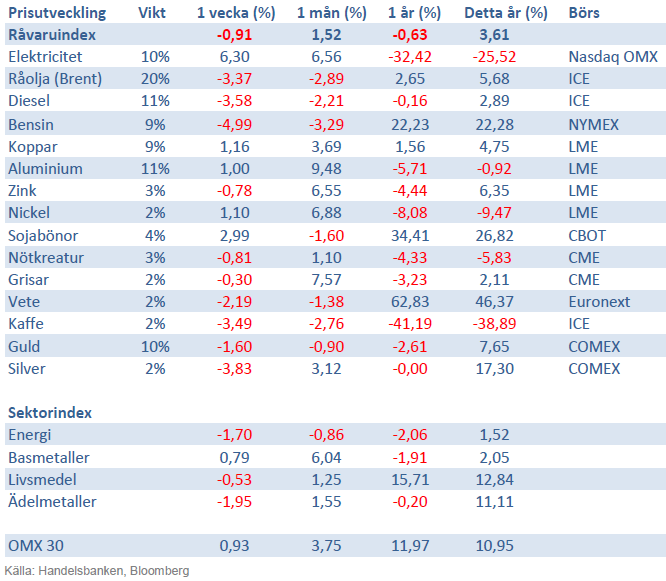
Handelsbankens råvaruindex består av de underliggande indexen för respektive råvara. Vikterna är bestämda till hälften från värdet av global produktion och till hälften från likviditeten i terminskontrakten.
[box]SHB Råvarubrevet är producerat av Handelsbanken och publiceras i samarbete och med tillstånd på Råvarumarknaden.se[/box]
Ansvarsbegränsning
Detta material är producerat av Svenska Handelsbanken AB (publ) i fortsättningen kallad Handelsbanken. De som arbetar med innehållet är inte analytiker och materialet är inte oberoende investeringsanalys. Innehållet är uteslutande avsett för kunder i Sverige. Syftet är att ge en allmän information till Handelsbankens kunder och utgör inte ett personligt investeringsråd eller en personlig rekommendation. Informationen ska inte ensamt utgöra underlag för investeringsbeslut. Kunder bör inhämta råd från sina rådgivare och basera sina investeringsbeslut utifrån egen erfarenhet.
Informationen i materialet kan ändras och också avvika från de åsikter som uttrycks i oberoende investeringsanalyser från Handelsbanken. Informationen grundar sig på allmänt tillgänglig information och är hämtad från källor som bedöms som tillförlitliga, men riktigheten kan inte garanteras och informationen kan vara ofullständig eller nedkortad. Ingen del av förslaget får reproduceras eller distribueras till någon annan person utan att Handelsbanken dessförinnan lämnat sitt skriftliga medgivande. Handelsbanken ansvarar inte för att materialet används på ett sätt som strider mot förbudet mot vidarebefordran eller offentliggörs i strid med bankens regler.
Analys
Tightening fundamentals – bullish inventories from DOE

The latest weekly report from the US DOE showed a substantial drawdown across key petroleum categories, adding more upside potential to the fundamental picture.

Commercial crude inventories (excl. SPR) fell by 5.8 million barrels, bringing total inventories down to 415.1 million barrels. Now sitting 11% below the five-year seasonal norm and placed in the lowest 2015-2022 range (see picture below).
Product inventories also tightened further last week. Gasoline inventories declined by 2.1 million barrels, with reductions seen in both finished gasoline and blending components. Current gasoline levels are about 3% below the five-year average for this time of year.
Among products, the most notable move came in diesel, where inventories dropped by almost 4.1 million barrels, deepening the deficit to around 20% below seasonal norms – continuing to underscore the persistent supply tightness in diesel markets.
The only area of inventory growth was in propane/propylene, which posted a significant 5.1-million-barrel build and now stands 9% above the five-year average.
Total commercial petroleum inventories (crude plus refined products) declined by 4.2 million barrels on the week, reinforcing the overall tightening of US crude and products.


Analys
Bombs to ”ceasefire” in hours – Brent below $70

A classic case of “buy the rumor, sell the news” played out in oil markets, as Brent crude has dropped sharply – down nearly USD 10 per barrel since yesterday evening – following Iran’s retaliatory strike on a U.S. air base in Qatar. The immediate reaction was: “That was it?” The strike followed a carefully calibrated, non-escalatory playbook, avoiding direct threats to energy infrastructure or disruption of shipping through the Strait of Hormuz – thus calming worst-case fears.

After Monday morning’s sharp spike to USD 81.4 per barrel, triggered by the U.S. bombing of Iranian nuclear facilities, oil prices drifted sideways in anticipation of a potential Iranian response. That response came with advance warning and caused limited physical damage. Early this morning, both the U.S. President and Iranian state media announced a ceasefire, effectively placing a lid on the immediate conflict risk – at least for now.
As a result, Brent crude has now fallen by a total of USD 12 from Monday’s peak, currently trading around USD 69 per barrel.
Looking beyond geopolitics, the market will now shift its focus to the upcoming OPEC+ meeting in early July. Saudi Arabia’s decision to increase output earlier this year – despite falling prices – has drawn renewed attention considering recent developments. Some suggest this was a response to U.S. pressure to offset potential Iranian supply losses.
However, consensus is that the move was driven more by internal OPEC+ dynamics. After years of curbing production to support prices, Riyadh had grown frustrated with quota-busting by several members (notably Kazakhstan). With Saudi Arabia cutting up to 2 million barrels per day – roughly 2% of global supply – returns were diminishing, and the risk of losing market share was rising. The production increase is widely seen as an effort to reassert leadership and restore discipline within the group.
That said, the FT recently stated that, the Saudis remain wary of past missteps. In 2018, Riyadh ramped up output at Trump’s request ahead of Iran sanctions, only to see prices collapse when the U.S. granted broad waivers – triggering oversupply. Officials have reportedly made it clear they don’t intend to repeat that mistake.
The recent visit by President Trump to Saudi Arabia, which included agreements on AI, defense, and nuclear cooperation, suggests a broader strategic alignment. This has fueled speculation about a quiet “pump-for-politics” deal behind recent production moves.
Looking ahead, oil prices have now retraced the entire rally sparked by the June 13 Israel–Iran escalation. This retreat provides more political and policy space for both the U.S. and Saudi Arabia. Specifically, it makes it easier for Riyadh to scale back its three recent production hikes of 411,000 barrels each, potentially returning to more moderate increases of 137,000 barrels for August and September.
In short: with no major loss of Iranian supply to the market, OPEC+ – led by Saudi Arabia – no longer needs to compensate for a disruption that hasn’t materialized, especially not to please the U.S. at the cost of its own market strategy. As the Saudis themselves have signaled, they are unlikely to repeat previous mistakes.
Conclusion: With Brent now in the high USD 60s, buying oil looks fundamentally justified. The geopolitical premium has deflated, but tensions between Israel and Iran remain unresolved – and the risk of missteps and renewed escalation still lingers. In fact, even this morning, reports have emerged of renewed missile fire despite the declared “truce.” The path forward may be calmer – but it is far from stable.
Analys
A muted price reaction. Market looks relaxed, but it is still on edge waiting for what Iran will do

Brent crossed the 80-line this morning but quickly fell back assigning limited probability for Iran choosing to close the Strait of Hormuz. Brent traded in a range of USD 70.56 – 79.04/b last week as the market fluctuated between ”Iran wants a deal” and ”US is about to attack Iran”. At the end of the week though, Donald Trump managed to convince markets (and probably also Iran) that he would make a decision within two weeks. I.e. no imminent attack. Previously when when he has talked about ”making a decision within two weeks” he has often ended up doing nothing in the end. The oil market relaxed as a result and the week ended at USD 77.01/b which is just USD 6/b above the year to date average of USD 71/b.

Brent jumped to USD 81.4/b this morning, the highest since mid-January, but then quickly fell back to a current price of USD 78.2/b which is only up 1.5% versus the close on Friday. As such the market is pricing a fairly low probability that Iran will actually close the Strait of Hormuz. Probably because it will hurt Iranian oil exports as well as the global oil market.
It was however all smoke and mirrors. Deception. The US attacked Iran on Saturday. The attack involved 125 warplanes, submarines and surface warships and 14 bunker buster bombs were dropped on Iranian nuclear sites including Fordow, Natanz and Isfahan. In response the Iranian Parliament voted in support of closing the Strait of Hormuz where some 17 mb of crude and products is transported to the global market every day plus significant volumes of LNG. This is however merely an advise to the Supreme leader Ayatollah Ali Khamenei and the Supreme National Security Council which sits with the final and actual decision.
No supply of oil is lost yet. It is about the risk of Iran closing the Strait of Hormuz or not. So far not a single drop of oil supply has been lost to the global market. The price at the moment is all about the assessed risk of loss of supply. Will Iran choose to choke of the Strait of Hormuz or not? That is the big question. It would be painful for US consumers, for Donald Trump’s voter base, for the global economy but also for Iran and its population which relies on oil exports and income from selling oil out of that Strait as well. As such it is not a no-brainer choice for Iran to close the Strait for oil exports. And looking at the il price this morning it is clear that the oil market doesn’t assign a very high probability of it happening. It is however probably well within the capability of Iran to close the Strait off with rockets, mines, air-drones and possibly sea-drones. Just look at how Ukraine has been able to control and damage the Russian Black Sea fleet.
What to do about the highly enriched uranium which has gone missing? While the US and Israel can celebrate their destruction of Iranian nuclear facilities they are also scratching their heads over what to do with the lost Iranian nuclear material. Iran had 408 kg of highly enriched uranium (IAEA). Almost weapons grade. Enough for some 10 nuclear warheads. It seems to have been transported out of Fordow before the attack this weekend.
The market is still on edge. USD 80-something/b seems sensible while we wait. The oil market reaction to this weekend’s events is very muted so far. The market is still on edge awaiting what Iran will do. Because Iran will do something. But what and when? An oil price of 80-something seems like a sensible level until something do happen.
-

 Nyheter4 veckor sedan
Nyheter4 veckor sedanStor uppsida i Lappland Guldprospekterings aktie enligt analys
-

 Nyheter4 veckor sedan
Nyheter4 veckor sedanSilverpriset släpar efter guldets utveckling, har mer uppsida
-

 Nyheter3 veckor sedan
Nyheter3 veckor sedanUppgången i oljepriset planade ut under helgen
-

 Nyheter2 veckor sedan
Nyheter2 veckor sedanMahvie Minerals växlar spår – satsar fullt ut på guld
-

 Nyheter3 veckor sedan
Nyheter3 veckor sedanLåga elpriser i sommar – men mellersta Sverige får en ökning
-

 Analys3 veckor sedan
Analys3 veckor sedanVery relaxed at USD 75/b. Risk barometer will likely fluctuate to higher levels with Brent into the 80ies or higher coming 2-3 weeks
-

 Nyheter2 veckor sedan
Nyheter2 veckor sedanOljan, guldet och marknadens oroande tystnad
-

 Nyheter2 veckor sedan
Nyheter2 veckor sedanJonas Lindvall är tillbaka med ett nytt oljebolag, Perthro, som ska börsnoteras


